Contents
Clover Club is a beautiful pink classic cocktail with a rich, complex taste and a pleasant silky texture. It’s a perfectly balanced evening drink that’s great to sip on, whether it’s in a calm, homely, dimly lit environment or in a noisy, light-filled bar. But beware, the person who orders or mixes just one Clover Club is a rare beast!
After a whole epic with gin, namely writing extensive material about the rules for drinking it and rethinking the guide about this drink as a whole, I saw only a classic cocktail dominated by juniper distillate as a logical conclusion to this story at this stage of the project development. Despite the appeal of Gin Fizz, French 75 and many other classic gin cocktails, I still chose the renaissance Clover Club as the object of study. Not because it is amazing, complex and multifaceted. Not because no one drinks chicken protein shakes now, but they should. Not because the gin in such a combination is revealed in the most interesting way. Not because… But why not?
Cocktail Clover Club / Clover Club
Cocktail recipe Clover Club from the official website of the IBA, category “Unforgettable”.
Prepare 1 minute
Cooking 1 minute
Total 2 minutes
Portions 1
Ingredients
- 45 ml gin
- 15 ml raspberry syrup (or grenadine)
- 15 ml lemon juice (freshly squeezed)
- a few drops of egg white
Instructions
Shake thoroughly in a shaker with ice.
Strain into a cocktail glass.
Field notes:
- A London dry or Plymouth gin is recommended for the cocktail, but feel free to use any other gin style (so-called botanical gins, such as Hendrick’s, do well). At the same time, try to find the highest quality product for your first Clover Club, because here it plays, as you understand, the most important role.
- Most of the “non-classic” Clover Club recipes (which are more preferable for exploring a cocktail) use a fairly large amount of egg white (often a whole protein from one small egg). To whip it well, which is a very important technological process (the protein must completely emulsify, give a silky texture and a delicate foam, without which it is not at all right), use a whipping technique known as a dry shake. To do this, beat all the ingredients for 30-60 seconds without ice (you can use a spring from a hawthorn strainer), and then an intense shake with ice until frost on a shaker.
- The classic cocktail contains raspberry syrup, but it is often replaced with grenadine, which works just as well, and even better with some gins. Of course, it’s best to make your own grenadine, just like the raspberry syrup recipe for which you can find below. If you do decide to use commercial grenadine, go for plain sugar syrup and a couple of dash of this grenadine. It is also not a shame to use blackcurrant syrup.

Raspberry syrup
- 250 g fresh raspberries (or black currants)
- 300 g + 2 tbsp. l. granulated sugar
- 230 + 345 ml water
- ½ tsp lemon juice (optional)
In a small saucepan, combine raspberries, a couple tablespoons of sugar and 230 ml of water. Heat over medium heat, stirring constantly, for about 4 minutes, until the berries begin to break down and let the juice flow. Then add lemon juice, 345 ml of water if desired, bring the mixture to a boil, reduce heat and simmer for 15 minutes. Periodically remove the white foam that forms on the surface.
Strain through a sieve into a clean container, rubbing the berries with a spoon to extract the maximum amount of juice. Return the resulting liquid to the pan, add 300 g of sugar and stir until it is completely dissolved. Bring the syrup to a boil and boil for 2 minutes over medium heat. Cool, store in a tightly closed container in the refrigerator for 3 weeks. To increase the shelf life of the syrup, you can add a little vodka.
- To get a Clover Leaf cocktail, one of the popular variations of our researcher, it is enough, as many respected bar people assure, to decorate the Clover Club with a mint leaf (in fact, logically, these leaves should be 3-4, imitating clover). Other no less respected bar people add this same mint leaf (even a couple) directly to the shaker.

- Some variations of Clover Club include dry or sweet vermouth, usually in an amount of 10-20 ml.
- Many Clover Club cocktail recipes use fresh raspberries (from a couple of berries to a whole handful), which must first be crushed in a shaker with a muddler or spoon.
- Lemon juice is traditionally used for a cocktail, but it can also be made with lime juice, which brings a slight astringency to the drink. But lemon juice gives a milder and more predictable result.
Variations on The Clover Club
Let’s start with the deeds of contemporaries and smoothly move to the fathers of mixology, and then how it goes. The famous cocktail historian David Vondrich shared the first recipe with the whole world. Remarkably, he did this as a columnist for Esquire magazine. In 1934, the same magazine named the Clover Club one of the ten worst cocktails of the past decade, feminine, slimy and generally fi. But 74 years later, Vondrich had to rehabilitate the cocktail in the eyes of readers, with apologies and other praises. Now they have Clover “unusual, tasty, strong and not slimy at all.”
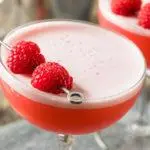
Clover Club by David Wondrich
- 60 ml of gin
- 1 egg white
- 15 ml lemon juice
- 3 dashes of raspberry syrup
Shake with crushed ice, strain into a cocktail glass.
The next variation will be the Clover Club by Dale DeGroff, the uncrowned “King of Cocktail”, the man who invented Cosmopolitan and published The Essential Cocktail: The Art of Mixing Perfect Drinks in 2008, from which this recipe is taken.
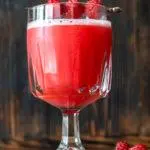
Clover Club by Dale DeGroff
- 45 ml of gin
- 20 ml simple syrup
- 20 ml lemon juice
- ½ no. l. grenadine
- 1 egg white
Beat the protein a little in a separate container. Shake all ingredients with half the beaten egg white over ice. Strain into a cocktail glass.
A more complex recipe is offered by Simon Difford, an encyclopedic man who seems to know everything about bar culture and alcoholic drinks in particular. Founder of one of the largest online publications on alcohol Diffords’s Guide.
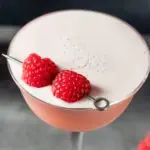
Clover Club by Simon Difford
- 5 fresh raspberries
- 50 ml of gin
- 7,5 ml dry vermouth
- 7,5 ml sweet red vermouth
- 7,5 ml lemon juice
- 7,5 ml sugar syrup (2:1)
- 15 ml egg white
Thorough shake with ice, fine strain into a cocktail glass.
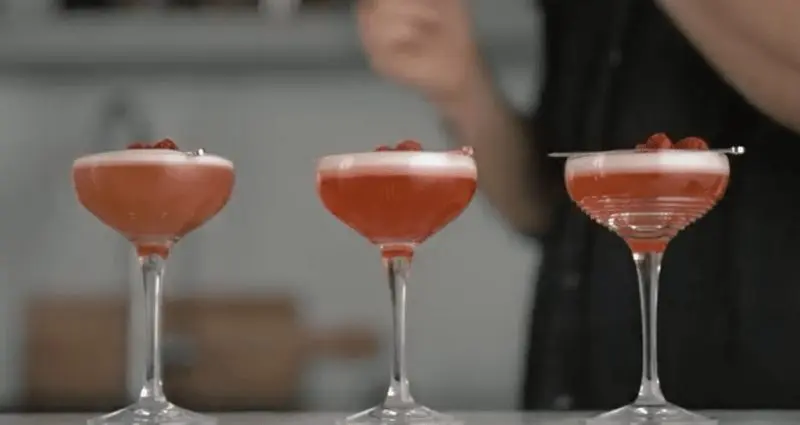
Well, a couple of “oldies” in the end. The first is Harry Craddock’s recipe from his 1930 The Savoy Cocktail Book. Needs no introduction.
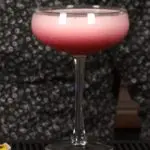
Clover Club Harry Craddock
- 50 ml of gin
- juice of ½ lemon or 1 lime (20-25 ml)
- 25 ml grenadine
- 1 egg white
Thorough shake with ice, strain into a cocktail glass.
The last of the “bar” Clover Clubs will be Paul E. Lowe’s version of his 1909 book Drinks – How to Mix and how to Serve. According to David Vondrich, this is the very first written mention of this cocktail. Lowe omitted lemon juice from the recipe, but this is considered a mistake.
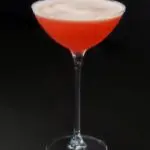
Clover Club Paul E. Lowe
- 30 ml of gin
- 30 ml dry vermouth
- 30 ml lemon juice
- 22,5 ml raspberry syrup (1 part juice to 1,5 parts sugar)
- 15 ml egg white
Thorough shake with ice, strain back into shaker. Dry shake and fine strain into a chilled cocktail glass.
Well, without this recipe, which was presented on the same Diffords’s Guide, the picture, in my opinion, will not be complete. This is an adaptation of a recipe by Julia Reiner, one of the top five bartenders in the world and founder of the Clover Club bar of the same name in Brooklyn. Ideal for home experiments with your grandmother’s favorite jams.

Clover Club by Julia Rayner (adaptation)
- 45 ml of gin
- 1,5 teaspoons of raspberry jam
- 15 ml dry vermouth
- 22,5 ml lemon juice
Thorough shake with ice, fine strain into a cocktail glass.
A Brief History of the Clover Club Cocktail
The Clover Club appeared long before Prohibition, in the Philadelphia men’s club of the same name, which met at the Bellevue-Stratford Hotel in the 1880s. It is not known when and by whom it was first prepared, but by 1910 it was sold far beyond Philadelphia, for example, at the Plaza Hotel in New York (according to one version, the cocktail came to New York with George Boldt, who in 1890 became the owner of the Waldorf Astoria hotel, and before that he was a co-owner in the same Bellevue-Stratford).
The first printed mention of Clover Club dates back to 1909, with the advent of the manual “Drinks – How to Mix and how to Serve” by the already mentioned Paul E. Low, who forgot to add lemon juice to the recipe. The cocktail recipe was also found in Jeanette Young Norton’s cookbook Mrs. Norton’s Cook-book: Selecting, Cooking, and Serving for the Home Table” 1917 (for the first time, French sweet vermouth appeared in the recipe).
Now Clover Club is experiencing a well-deserved renaissance, but fate has not always been favorable to him. Since his devastating Esquire article, he has moved from the masculine and fine drink echelon to the women’s mix section of almost every cocktail guide. The situation was aggravated by the popularization in the 50s of the Dry Martini as a worthy male gin cocktail, as well as the Pink Lady, whose color and composition similar to the Clover Club, completely ruined the latter’s reputation in the eyes of respectable gentlemen. Add to this the widespread fear of the terrible salmonella (ovophobia) and the complexity of cooking, because whipping egg white to the desired consistency is quite problematic and requires some physical effort.
Fortunately, most connoisseurs of classical mixology at some point realized that Clover Club, despite its composition and complexity, is an amazing and underestimated cocktail. But only very diligent and dedicated mixologists can cook it really tasty. Don’t skimp on a good gin, make your own syrups and don’t skimp on the dry shake, because the amazing silky texture and beautiful frothy cap of the Clover Club cocktail really deliver.
Good luck in your endeavors!









